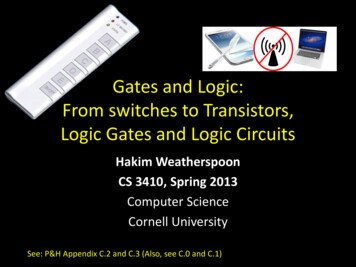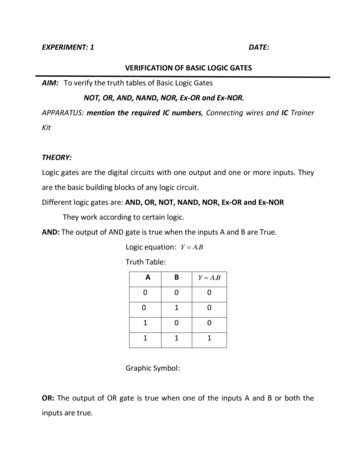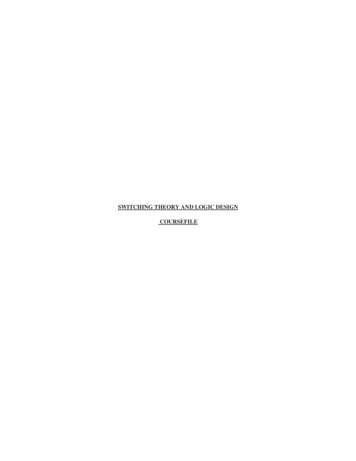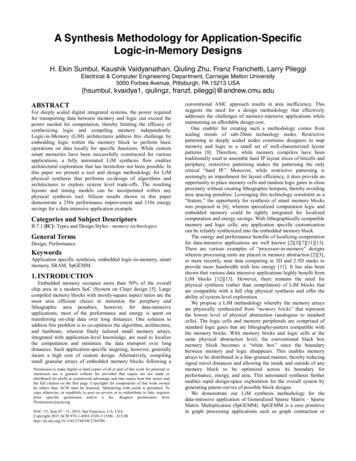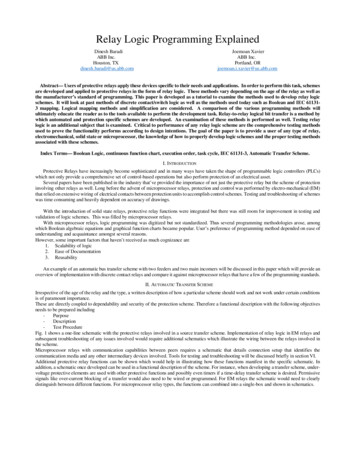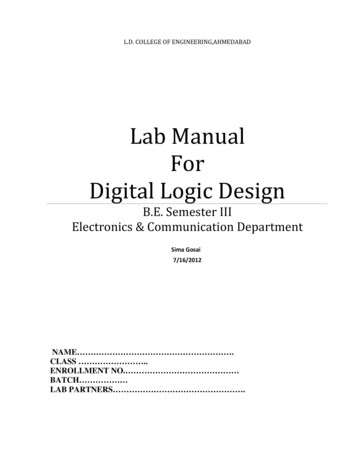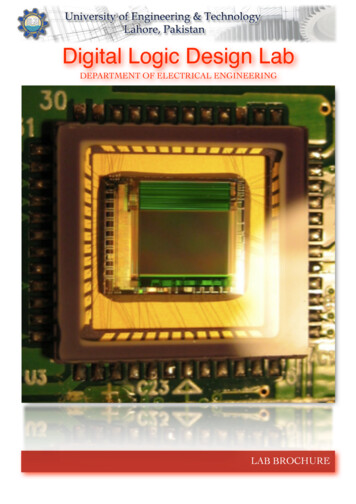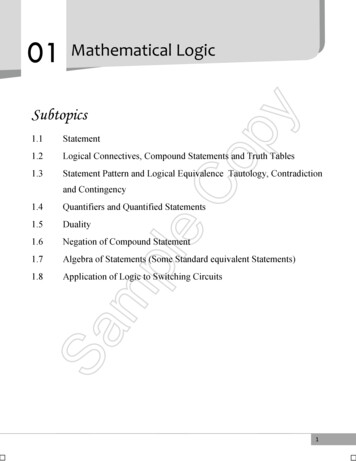
Transcription
Chapter 01: Mathematical Logic01Mathematical LogicSubtopics1.1Statement1.2Logical Connectives, Compound Statements and Truth Tables1.3Statement Pattern and Logical Equivalence Tautology, Contradictionand Contingency1.4Quantifiers and Quantified Statements1.5Duality1.6Negation of Compound Statement1.7Algebra of Statements (Some Standard equivalent Statements)1.8Application of Logic to Switching Circuits1
Std. XII : Perfect Maths - IType of ProblemsIdentify the statements and writedown their Truth ValueExpress the statements in SymbolicForm/Write the statement inSymbolic FormWrite /Using the RulesNegation write the NegationStatementsWrite the Verbal statement forgiven Symbolic ive of the statementUsing Quantifiers Convert Opensentences into True statementPrepare the Truth Table/Find TruthValues of p and q for given 21.41.6Miscellaneous1.31.8Q.1Q.1Q.1Q.1, 2Q.5Q.2Q.3, 5Q.1Q.2, 3, 9Q.1Q.1, 2, 4MiscellaneousQ.4, 11, 221.4Miscellaneous1.4MiscellaneousQ.6Q.6Q.4Q.19, 211.6Q.21.4Q.71.5Q.1MiscellaneousExamine the statement Patterns(Tautology,Contradiction,Contingency)Using Truth Table, Verify LogicalEquivalenceQ. Nos.1.5Miscellaneous1.5MiscellaneousQ. 12, 15Q.3Q.13, 14, 16Q.2Q.7, 18Write Dual of the statement1.7Q.1, 2, 3, 4Algebra of statements (withoutusing Truth Table verify the LogicalEquivalence)/Rewrite the statementwithout using the conditional form1.8Q.3Change the statements in the form ifthenApplications of logic to switchingcircuitsMiscellaneousQ.8, 17, 20MiscellaneousQ.101.9Miscellaneous2Q.1 to 5Q.23 to 29
Chapter 01: Mathematical LogicIntroductionMathematics is an exact science. Everymathematical statement must be precise. Hence,there has to be proper reasoning in everymathematical proof.Proper reasoning involves logic. The study of logichelps in increasing one’s ability of systematic andlogical reasoning. It also helps to develop the skillsof understanding various statements and theirvalidity.Logic has a wide scale application in circuitdesigning, computer programming etc. Hence, thestudy of logic becomes essential.Statement and its truth valueThere are various means of communication viz.,verbal, written etc. Most of the communicationinvolves the use of language whereby, the ideas areconveyed through sentences.There are various types of sentences such as:i.Declarative (Assertive)ii.Imperative (A command or a request)iii. Exclamatory (Emotions, excitement)iv. Interrogative (Question)StatementA statement is a declarative sentence which is eithertrue or false but not both simultaneously. Statementsare denoted by the letters p, q, r .For example:i.3 is an odd number.ii.5 is a perfect square.iii. Sun rises in the east.iv. x 3 6, when x 3.Truth ValueA statement is either True or False. The Truth valueof a ‘true’ statement is defined to be T (TRUE) andthat of a ‘false’ statement is defined to be F(FALSE).Note: 0 and 1 can also be used for T and Frespectively.Consider the following statements:i.There is no prime number between 23 and 29.ii.The Sun rises in the west.iii. The square of a real number is negative.iv. The sum of the angles of a plane triangle is180 .Here, the truth value of statement i. and iv. is T andthat of ii. and iii. is F.Note:The sentences like exclamatory, interrogative,imperative etc., are not considered as statements asthe truth value for these statements cannot bedetermined.Open sentenceAn open sentence is a sentence whose truth can varyaccording to some conditions, which are not statedin the sentence.Note:Open sentence is not considered as statement in logic.For example:i.x 5 20This is an open sentence as its truth dependson value of x (if x 4, it is true and if x 4, itis false).ii.Chinese food is very tasty.This is an open sentence as its truth variesfrom individual to individual.Exercise 1.1State which of the following sentences arestatements. Justify your answer. In case of thestatements, write down the truth value.i.The Sun is a star.ii.May God bless you!iii. The sum of interior angles of a triangle is180 .iv. Every real number is a complex number.v.Why are you upset?vi. Every quadratic equation has two realroots.vii. 9 is a rational number.2viii. x 3x 2 0, implies that x 1 or x 2.ix.The sum of cube roots of unity is one.x.Please get me a glass of water.xi. He is a good person.xii. Two is the only even prime number.xiii. sin 2θ 2sin θ cos θ for all θ R.xiv. What a horrible sight it was!xv. Do not disturb.xvi. x2 3x 4 0, x 1.xvii. Can you speak in French?xviii. The square of every real number is positive.xix. It is red in colour.xx. Every parallelogram is a rhombus.3
Std. XII : Perfect Maths - ISolution:i.It is a statement which is true, hence its truthvalue is ‘T’.ii.It is an exclamatory sentence, hence, it is not astatement.iii. It is a statement which is true, hence its truthvalue is ‘T’.iv. It is a statement which is true, hence its truthvalue is ‘T’.v.It is an interrogative sentence, hence it is not astatement.vi. It is a statement which is false, hence its truthvalue is ‘F’.vii. It is a statement which is false, hence its truthvalue is ‘F’.viii. It is a statement which is false, hence its truthvalue is ‘F’.ix. It is a statement which is false, hence its truthvalue is ‘F’.x.It is an imperative sentence, hence it is not astatement.xi. It is an open sentence, hence it is not astatement.xii. It is a statement which is true, hence its truthvalue is ‘T’.xiii. It is a statement which is true, hence its truthvalue is ‘T’.xiv. It is an exclamatory sentence, hence it is not astatement.xv. It is an imperative sentence, hence it is not astatement.xvi. It is a statement which is true, hence its truthvalue is ‘T’.xvii. It is an interrogative sentence, hence, it is nota statement.xviii. It is a statement which is false, hence its truthvalue is ‘F’. (Since, 0 is a real number andsquare of 0 is 0 which is neither positive nornegative).xix. It is an open sentence, hence it is not astatement. (The truth of this sentence dependsupon the reference for the pronoun ‘It’.)xx. It is a statement which is false, hence its truthvalue is ‘F’.Logical Connectives, Compound Statements andTruth TablesLogical Connectives:The words or group of words such as “and, or, if .then, if and only if, not” are used to join or connecttwo or more simple sentences. These connectingwords are called logical connectives.4Compound Statements:The new statement that is formed by combining twoor more simple statements by using logicalconnectives are called compound statements.Component Statements:The simple statements that are joined using logicalconnectives are called component statements.For example:Consider the following simple statements,i.e is a vowelii.b is a consonantThese two component statements can be joined byusing the logical connective ‘or’ as shown below:‘e is a vowel or b is a consonant’The above statement is called compound statementformed by using logical connective ‘or’.Truth TableA table that shows the relationship between truthvalues of simple statements and the truth values ofcompounds statements formed by using these simplestatements is called truth table.Note:The truth value of a compoud statement dependsupon the truth values of its component statements.Logical ConnectivesA.AND [ ] (Conjunction):If p and q are any two statements connectedby the word ‘and’, then the resultingcompound statement ‘p and q’ is calledconjunction of p and q which is written in thesymbolic form as ‘p q’.For example:p: Today is a pleasant day.q: I want to go for shopping.The conjunction of above two statements is‘p q’ i.e. ‘Today is a pleasant day and I wantto go for shopping’.A conjunction is true if and only if both p andq are true.Truth table for conjunction of p and q is asshown below:pTTFFqTFTFp qTFFF
Chapter 01: Mathematical LogicNote:The words such as but, yet, still, inspite,though, moreover are also used to connect thesimple statements.These words are generally used by replacing‘and’.B.OR [ ] (Disjunction):If p and q are any two statements connected bythe word ‘or’, then the resulting compoundstatement ‘p or q’ is called disjunction of p andq which is written in the symbolic form as‘p q’.The word ‘or’ is used in English language intwo distinct senses, exclusive and inclusive.For example:i.Rahul will pass or fail in the exam.ii.Candidate must be graduate orpost-graduate.In eg. (i), ‘or’ indicates that only one of thetwo possibilities exists but not both which iscalled exclusive sense of ‘or’. In eg. (ii), ‘or’indicates that first or second or both thepossibilities may exist which is calledinclusive sense of ‘or’.A disjunction is false only when both p and qare false.Truth table for disjunction of p and q is asshown below:pTTFFqTFTFp qTTTFExercise 1.21.Express the following statements insymbolic form:i.Mango is a fruit but potato is avegetable.ii.Either we play football or go forcycling.iii. Milk is white or grass is green.iv. Inspite of physical disability, Rahulstood first in the class.v.Jagdish stays at home while Shrijeetand Shalmali go for a movie.Solution:i.Let p : Mango is a fruit, q : Potato is a vegetable. The symbolic form of the given statement isp q.ii. Let p : We play football, q : We go for cycling.The symbolic form of the given statement isp q.iii. Let p : Milk is white, q : Grass is green.The symbolic form of the given statement isp q.iv.Let p : Rahul has physical disability,q : Rahul stood first in the class.The given statement can be considered as ‘Rahulhas physical disability and he stood first in theclass.’The symbolic form of the given statement isp q. v. Let p : Jagdish stays at home,q : Shrijeet and Shalmali go for a movie.The given statement can be considered as‘Jagdish stays at home and Shrijeet and Shalmaligo for a movie.’The symbolic form of the given statement isp q.2.Write the truth values of followingstatements.i.3 is a rational number or 3 i is acomplex number.ii.Jupiter is a planet and Mars is a star.iii. 2 3 5 or 2 3 5iv. 2 0 2 and 2 0 2v.9 is a perfect square but 11 is a primenumber.vi. Moscow is in Russia or London is inFrance.Solution:i.Let p : 3 is a rational number,q : 3 i is a complex number. The symbolic form of the given statement isp q.Since, truth value of p is F and that of q is T. truth value of p q is Tii. Let p : Jupiter is a planet,q : Mars is a star.The symbolic form of the given statement isp q.Since, truth value of p is T and that of q is F.truth value of p q is F5
Std. XII : Perfect Maths - Iiii. iv.Let p : 2 3 5,q : 2 3 5.The symbolic form of the given statement isp q.Since, truth value of both p and q is F.truth value of p q is FLet p : 2 0 2,q : 2 0 2.The symbolic form of the given statement isp q.Since, truth value of p is F and that of q is T.truth value of p q is F v.Let p : 9 is a perfect square,q : 11 is a prime number.The symbolic form of the given statement isp q.Since, truth value of both p and q is T.truth value of p q is T vi.Let p : Moscow is in Russia,q : London is in France.The symbolic form of the given statement isp q.Since, truth value of p is T and that of q is F.truth value of p q is T C.Not [ ] (Negation):If p is any statement then negation of pi.e., ‘not p’ is denoted by p. Negation of anysimple statement p can also be formed bywriting ‘It is not true that’ or ‘It is false that’,before p.For example:p : Mango is a fruit. p : Mango is not a fruit.Truth table for negation is as shown below:pTF pFTNote: If a statement is true its negation is falseand vice-versa.Exercise 1.3Write negations of the following statements:i.Rome is in Italy.ii.5 5 10iii. 3 is greater than 4.iv. John is good in river rafting.v.π is an irrational number.vi. The square of a real number is positive.6vii. Zero is not a complex number.viii. Re (z) z .ix. The sun sets in the East.x.It is not true that the mangoes are inexpensive.Solution:i.Rome is not in Italy.ii.5 5 10iii. 3 is not greater than 4.iv. John is not good in river rafting.v.π is not an irrational number.vi. The square of a real number is not positive.vii. Zero is a complex number.viii. Re (z) z .ix. The sun does not set in the East.x.It is true that the mangoes are inexpensive.D.If .then (Implication, ) (Conditional):If p and q are any two simple statements, thenthe compound statement, ‘if p then q’,meaning “statement p implies statement q orstatement q is implied by statement p”, iscalled a conditional statement and is denotedby p q or p q.Here p is called the antecedent (hypothesis)and q is called the consequent (conclusion).For example:Let p: I travel by train.q: My journey will be cheaper.Here the conditional statement is‘p q: If I travel by train then my journeywill be cheaper.’Conditional statement is false if and only ifantecedent is true and consequent is false.Truth table for conditional is as shownbelow:pTTFFqTFTFp qTFTTNote: Equivalent forms of the conditionalstatementp q:a.p is sufficient for q.b.q is necessary for p.c.p implies q.d.p only if q.e.q follows from p.
Chapter 01: Mathematical LogicE.Converse, Inverse and Contrapositivestatements:If p q is given, then itsconverse isq pinverse is p qcontrapositive is q pFor example:Let p : Smita is intelligent.q : Smita will join Medical.i.q p: If Smita joins Medical then sheis intelligent.ii. p q: If Smita is not intelligent thenshe will not join Medical.iii. q p: If Smita does not join Medicalthen she is not intelligent.Consider, the following truth table:pTTFFq p qTTFFTTFT p qF FF TT FT Tq p q pTTTFFTTT p qTTFTFrom the above table, we conclude thati.a conditional statement and itscontrapositive are always equivalent.ii.converse and inverse of the conditionalstatement are always equivalent.F.If and only if (Double Implication, )(Biconditional):If p and q are any two statements, then‘p if and only if q’ or ‘p iff q’ is called thebiconditional statement and is denoted byp q. Here, both p and q are calledimplicants.For example:Let p : price increasesq : demand fallsHere the Biconditional statement is‘p q : Price increases if and only if demandfalls’.A biconditional statement is true if and only ifboth the implicants have same truth value.Truth table for biconditional is as shownbelow:pTTFFqTFTFp qTFFTExercise 1.41.Express the following in symbolic form.i.I like playing but not singing.ii.Anand neither likes cricket nor tennis.iii. Rekha and Rama are twins.iv. It is not true that ‘i’ is a real number.v.Either 25 is a perfect square or 41 isdivisible by 7.vi. Rani never works hard yet she getsgood marks.vii. Eventhough it is not cloudy, it is stillraining.Solution:i.Let p: I like playing, q: I like singing, The symbolic form of the given statement isp q.ii. Let p: Anand likes cricket, q: Anand likes tennis.The symbolic form of the given statement is p q.iii.In this statement ‘and’ is combining two nounsand not two simple statements.Hence, it is not used as a connective, so givenstatement is a simple statement which can besymbolically expressed as p itself.iv. Let, p : ‘i’ is a real number.The symbolic form of the given statement is p.v.Let p : 25 is a perfect square,q : 41 is divisible by 7.The symbolic form of the given statement isp q. vi. Let p : Rani works hard, q : Rani gets goodmarks.The symbolic form of the given statement is p q.vii. Let p : It is cloudy, q : It is still raining.The symbolic form of the given statement is p q.2.If p: girls are happy, q: girls are playing,express the following sentences in symbolicform.i.Either the girls are happy or they arenot playing.ii.Girls are unhappy but they areplaying.iii. It is not true that the girls are notplaying but they are happy.7
Std. XII : Perfect Maths - ISolution:i.p qiii.ii. p q ( q p)3.Find the truth value of the followingstatements.i.14 is a composite number or 15 is aprime number.ii.Neither 21 is a prime number nor it isdivisible by 3.iii. It is not true that 4 3i is a realnumber.iv. 2 is the only even prime number and 5divides 26.v.Either 64 is a perfect square or 46 is aprime number.vi. 3 5 7 if and only if 4 6 10.Solution:i.Let p : 14 is a composite number,q : 15 is a prime number. The symbolic form of the given statement isp q.Since, truth value of p is T and that of q is F. truth value of p q is T.ii.Let p: 21 is a prime number,q: 21 is divisible by 3.The symbolic form of the given statement is p q.Since, truth value of p is F and that of q is Ttruth value of p q is F. iii. iv.vi. 4.Statetheconverse,inverseandcontrapositive of the following conditionalstatements:i.If it rains then the match will becancelled.ii.If a function is differentiable then it iscontinuous.iii. If surface area decreases then thepressure increases.iv. If a sequence is bounded then it isconvergent.Solution:i.Let p : It rains, q : the match will be cancelled. The symbolic form of the given statement isp q.Converse: q pi.e., If the match is cancelled then it rains.Inverse: p qi.e., If it does not rain then the match will not becancelled.Contrapositive: q pi.e. If the match is not cancelled then it doesnot rain.ii. Let p: 4 3i is a real number.The symbolic form of the given statement is p.Since, truth value of p is F.truth value of p is T.Let p: 2 is the only even prime number,q: 5 divides 26.The symbolic form of the given statement isp q.Since, truth value of p is T and that of q is Ftruth value of p q is F. v.Let p: 64 is a perfect square,q: 46 is a prime number.The symbolic form of the given statement isp q.Since, truth value of p is T and that of q is F.truth value of p q is T 8Let p: 3 5 7, q: 4 6 10The symbolic form of the given statement isp q.Since, truth value of p is T and that of q is F.truth value of p q is Fiii. Let p: A function is differentiable,q: It is continuous.The symbolic form of the given statement isp q.Converse: q pi.e. If a function is continuous then it isdifferentiable.Inverse: p qi.e. If a function is not differentiable then itis not continuous.Contrapositive: q pi.e. If a function is not continuous then it isnot differentiable.Let p: Surface area decreases,q: The pressure increases.The symbolic form of the given statement isp qConverse: q pi.e. If the pressure increases then the surfacearea decreases.
Chapter 01: Mathematical LogicInverse: p qi.e. If the surface area does not decreasethen the pressure does not increase.Contrapositive: q pi.e. If the pressure does not increase then thesurface area does not decrease.iv. Let p: A sequence is bounded,q: It is convergent.The symbolic form of the given statement isp qConverse: q pi.e. If a sequence is convergent then it isbounded.Inverse: p qi.e. If a sequence is not bounded then it isnot convergent.Contrapositive: q pi.e. If a sequence is not convergent then it isnot bounded.5.If p and q are true and r and s are falsestatements, find the truth value of thefollowing statements:i.(p q) rii.p (r s)iii. (p s) (q r)iv. (p r) ( q s)Solution:Given that p and q are T and r and s are F.i.(p q) r (T T) F T F T truth value of the given statement is true.ii. iii. p (r s) T (F F) T T Ttruth value of the given statement is true.(p s) (q r) (T F) (T F) T F Ftruth value of the given statement is false.iv. (p r) ( q s) (T T) (F F) (T) F F F Ftruth value of the given statement is false.6.If p: It is daytime, q: It is warmGive the compound statements in verbalform denoted byi.p q[Oct 14]ii.p qiii. p qiv. q p[Oct 14]Solution:i.It is daytime but it is not warm.[1 Mark]ii.It is daytime or it is warm.iii. If it is daytime then it is warm.iv. It is warm if and only if it is daytime.[1 Mark]7.Prepare the truth tables for the following:i. p qii.p (p q)iii. p qSolution:i. p qpTTFFii. p qFFTFp (p q)pTTFFiii.q pT FF FT TF Tq p qTTFTTTFFp (p q)TTTT p qpTTFFq pT FF FT TF T p qFTTF9
Std. XII : Perfect Maths - IStatement Pattern and Logical EquivalenceA.B.Statement PatternLet, p, q, r, be simple statements. Acompound statement obtained from thesesimple statements and by using one or moreconnectives , , , , is called astatement pattern.Following points must be noted whilepreparing truth tables of the statementpatterns:i.Parenthesesmust beintroducedwherever necessary.For example: (p q) and p q are not the same.ii.If a statement pattern consists of ‘n’statements and ‘m’ connectives, thentruth table consists of 2n rows and(m n) columns.Logical equivalenceTwo logical statements are said to beequivalent if and only if the truth values intheir respective columns in the joint truth tableare identical.If S1 and S2 are logically equivalent statementpatterns, we writeS1 S2.For example:To prove: p q (p q)[Mar 08]pTTFFq p q qTTFFFTTFFFFT(p q) (p q)FTTFTFTFIn the above truth table, all the entries in thecolumns of p q and (p q) are identical. p q (p q).Note:i. (p q) p q (De-Morgan’s 1st Law)[Mar 96]identicalpTTFF10q p qT F FF F TT T FF T Tp qTTTF (p q) p qFFFFFFTTii. (p q) p q (De-Morgan’s 2nd Law)identicalpTTFFiii.q p qT F FF F TT T FF T Tp q (p q) p qTFFFTTFTTFTTp q ( p) qidenticalpTTFFiv.pTTFFqTFTF pFFTTp qlTFTT p qTFTTp q (p q) (q p)[Mar 98, Oct 00, 01,04]identicalqTFTFp q q p p q (p q) (q p)TTTTFTFFTFFFTTTTTautology, Contradiction and ContingencyTautologyA statement pattern having truth value always T,irrespective of the truth values of its componentstatement is called Tautology.For example, consider (p q) (q p)p qT TT FF TF Fp qTFFTq pTFFT(p q) (q p)TTTTIn the above truth table, all the entries in the lastcolumn are T. The given statement pattern is a tautology.ContradictionA statement pattern having truth value always F,irrespective of the truth values of its componentstatement is called a Contradiction.
Chapter 01: Mathematical Logicii.For example, consider p ppTF pFTp pFFIn the above truth table, all the entries in the last columnare F. The given statement pattern is a contradiction.iii.ContingencyqTTFFTFTFpq p q q p q (p q)TTFFTFTFFTFTFTTTTFFF(p q) (p q)TFFFiv.In the above truth table, the entries in the lastcolumn are a combination of T and F. The given statement pattern is neither atautology nor a contradiction, it is acontingency.Exercise 1.51.Prepare the truth table of the followingstatement patterns:i.[(p q) q] pii.(p q) ( p)iii. (p q) ( p q)iv. (p r) (q p)v.(p q) (r p)Solution:i.[(p q) q] pq p q (p q) q [(p q) q] pT TTTF FFTT TTFF TFTNote:Here, the statement pattern consists of 2statements and 3 connectives. Therefore, the truthtable has,Number of rows 22 4and number of columns (2 3) 5.v.2. pp qTFFF(p q) ( p)FTTTFFTT(p q) ( p q)qp q p p qTFTTFFTTTFTTT TT FF TF FFor example, consider (p q) (p q)pTTFFppA statement pattern which is neither a tautology nora contradiction is called Contingency.TFFT(p q) ( p)(p q) ( p q)TTTT(p r) (q p)pqrp rq p(p r) (q (p q) (r p)pqr qp qr p q) (r p)TFTFTTFFUsing truth tables, prove the followinglogical equivalences:i.(p q) (p q)ii.p q (p q) ( p q)[Mar 13; Oct 15]iii. (p q) r p (q r) [Oct 14]iv. p (q r) (p q) (p r)11
Std. XII : Perfect Maths - Iiv.Solution:i.123456pqp q qp q (p q)TTTFFTTFFTFFTFTTFFFFFTTFThe entries in the columns 3 and 6 are identical.1pTTTTFFFF(p q) (p q) ii.1 234567TTFFTFTFTFFTF FF TT FT TTFFF(p q) ( p q)FFFTTFFTThe entries in columns 3 and 8 are identical.p q (p q) ( p q) [1 Mark][1 mark each for column 3 and column 8]iii.123456pqrp qq r(p q) p q) r p (q r)7p (q r)TFTTTTTT 78p r (p q) (p r)TTTTTTTTTTFFTFFFThe entries in the columns 5 and 8 are identicalp (q r) (p q) (p r)In the above truth table, all the entries in the lastcolumn are F.(p q) (p q) is a contradiction. [1 Mark][1 mark each for column 5 and column 6]ii.p[1 Mark][1 mark each for column 6 and column 7]126p qTTTTTTFFUsing truth tables examine whether thefollowing statement patterns are tautology,contradiction or contingency.i.(p q) (p q)[Mar 13]ii.( p q) (q p)iii. (p q) (p r)iv. [(p q) r] [p (q r)]v.(p q) (p r)Solution:i.1 2 3456(p q) p q q p q p q(p q)T T FFTFT F TTFFF T FFTFF F TFTFThe entries in the columns 6 and 7 are identical. 3 45r q r p (q r)T TTF FTT FTF FTT TTF FFT FFF FF3.8p q p q p q p q p q2qTTFFTTFF q p p qq pT TT FF TF FFFTTFFTFTTFT( p q) (q p)FFFFIn the above truth table, all the entries in the lastcolumn are F.( p q) (q p) is a contradiction.
Chapter 01: Mathematical Logiciii.i.pTTTTFFFFqTTFFTTFFrTFTFTFTFp qTTFFFFFFp rTFTFFFFF(p q) (p r)TTTFFFFFiv.ii.p qTTTTFFFF TTFFTTFFr p q q r (p q) p (q r) [(p q) r] r [p (q r)]T TTTTTF TTTTTT TTTTTF TFTTTT TTTTTF TTTTTT FTTTTF FFFFTIn the above truth table, all the entries in the lastcolumn are T.[(p q) r] [p (q r)] is a tautology.v. For example, Consider A {1, 2, 3}Let p: x A, x 4Here, the statement p uses the quantifier ‘forall’( ).This statement is true if and only if each andevery element of set A satisfies the condition‘x 4’ and is false otherwise.Here, the given statement is true for all theelements of set A, as 1, 2, 3 satisfy thecondition, ‘x A, x 4’.In the above truth table, the entries in the lastcolumn are a combination of T and F.(p q) (p r) is a contingency. p q r p q p r(p q) (p r)T T TTTTT T FTTTT F TTTTT F FTTTF T TTTTF T FTFFF F TFTFF F FFFFIn the above truth table, the entries in the lastcolumn are a combination of T and F.(p q) (p r) is a contingency.Quantifiers and Quantified StatementsQuantifiersQuantifiers are the symbols used to denote a groupof words or a phrase. Generally, two types ofquantifiers are used. They are as follows:Universal Quantifier:The symbol ‘ ’ stands for “all values of” andis known as universal quantifier.Existential Quantifier:The symbol ‘ ’ stands for ‘there exists’ and isknown as existential quantifier.For example, Consider A {4, 14, 66, 70}.Let p: x A such that x is an odd number.Here, the statement p uses the quantifier ‘thereexists’ ( ).This statement is true if atleast one element ofset A satisfies the condition ‘x is an oddnumber’ and is false otherwise.Here, the given statement is false as none ofthe elements of set A satisfy the condition,‘x A such that x is an odd number’.Quantified statementThe statement containing quantifiers is known asquantified statement. Generally, an open sentencewith a quantifier becomes a statement and is calledquantified statement.For example:Use quantifiers to convert open sentence x 2 4into a statement.Solution: x N such that x 2 4, is a truestatement, since x 1 N satisfies x 2 4.Exercise 1.61.If A {3, 4, 6, 8}, determine the truth valueof each of the following:i.ii.iii.iv.v. x A, such that x 4 7 x A, x 4 10. x A, x 5 13. x A, such that x is odd. x A, such that (x 3) N13
Std. XII : Perfect Maths - ISolution:i.Since x 3 A, satisfies x 4 7 the given statement is true. Its truth value is ‘T’.ii. Since x 6, 8 A, do not satisfy x 4 10,the given statement is false.Its truth value is ‘F’iii. Since x 3, 4, 6 A, do not satisfy x 5 13,the given statement is false.Its truth value is ‘F’.iv. Since x 3 A, satisfies the given statement,the given statement is true.Its truth value is ‘T’.v. Since x 4, 6, 8 A, satisfy (x 3) N,the given statement is true.Its truth value is ‘T’.2.Use quantifiers to convert each of thefollowing open sentences defined on N, intoa true statement:i.x2 25ii.2x 3 15iii. x 3 11iv. x2 1 5v.x2 3x 2 0Solution:i. x N, such that x2 25.This is a true statement since x 5 Nsatisfies x2 25.ii. x N, such that 2x 3 15.This is a true statement since x 1, 2, 3, 4, 5 N satisfy 2x 3 15.iii. x N such that x 3 11.This is a true statement since x 14 Nsatisfies x 3 11.iv. x N, such that x2 1 5.This is a true statement since x 1, 2 Nsatisfy x2 1 5.v. x N such that x2 3x 2 0.This is a true statement since x 1, 2 Nsatisfy x2 3x 2 0.Remarks:i.The symbol ‘ ’ is not changed while findingthe dual.ii.Dual of a dual is the statement itself.iii. The special statements ‘t’ (tautology) and ‘c’(contradiction) are duals of each other.iv. T is changed to F and vice-versa.Principle of Duality:If a compound statement S1 contains only , and and statement S2 arises from S1 by replacing by and by , then S1 is a tautology if and only if S2 isa contradiction.Exercise 1.71.Write the duals of the following statements:i.(p q) rii.T (p q)iii. p [ q (p q) r]Solution:i.(p q) rii.F (p q)iii. p [ q (p q) r]2.Write the dual statement of each of thefollowing compound statements:i.Vijay and Vinay cannot speak Hindi.ii.Ravi or Avinash went to Chennai.iii. Madhuri has curly hair and browneyes.[Mar 14]Solution:i.Vijay or Vinay cannot speak Hindi.ii.Ravi and Avinash went to Chennai.iii. Madhuri has curly hair or brown eyes. [1 Mark]3.Write the duals of the following statements:i.(p q) r p (q r)ii.p (q r) (p q) (p r)Solution:i.(p q) r p (q r)ii.p (q r) (p q) (p r)DualityTwo compound statements S1 and S2 are said to beduals of each other, if one can be obtained from theother
ii. 5 is a perfect square. iii. Sun rises in the east. iv. x 3 6, when x 3. Truth Value A statement is either True or False. The Truth value of a ‘true’ statement is defined to be T (TRUE) and that of a ‘false’ statement is defined to be F (FALSE).


